 Leading Blog | Posts by Month |
 Leading Blog | Posts by Month |
06.30.09

LeadershipNow 140: June 2009 Compilation
Posted by Michael McKinney at 10:09 AM
06.29.09

The Upside of the Downturn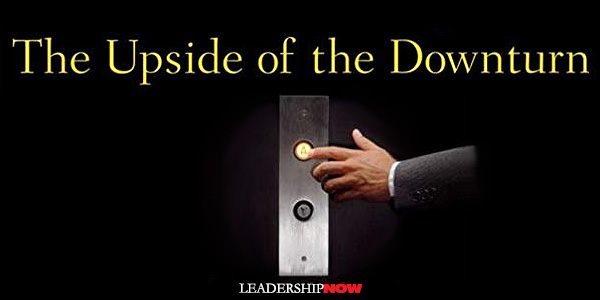
WHILE WE recognize that nothing good can be said about the misery that people are experiencing as a result of the current financial crisis, it is a “rare moment when we all face the greatest possible opportunity to make ourselves winners for a long time to come,” says Geoff Colvin in The Upside of the Downturn. In his standard brisk, clean and engaging style, Colvin argues that the recession has created a new world in which the U.S. economy will be less consumer-driven and consumer-focused, social attitudes toward working, saving, spending, and borrowing will shift, the world economy will become less U.S. centric, investors will remain spooked for a long time, and, as you might expect, government will play a much larger role. He contends that the best companies will respond in ten particular ways beginning with resetting your priorities. To borrow from Max DePree, "the first responsibility of a leader is to define reality" and then to understand exactly what that means for you and your organization or as Colvin puts it, “to understand the challenges of what you see, is the first crucial step toward finding opportunities in this recession.” Colvin then advises:Protect Your Most Valuable Asset. Layoffs are more costly than you think and are not always the best answer. Toyota’s policy of keeping employees on staff during recessions (and giving them extra training) means that when the economy turns up, those employees are in the plant, ready to go, and far better prepared than the employees of any competitor. Reexamine Your Strategy and Business Model. Excellent companies are certain of their core and focus their attention there. Kohl’s actually spent more on marketing in the recessionary 2008 holiday season than it had in 2007 because marketing is an essential part of their core. Create New Solutions for Customers’ New Problems. Instead of cutting prices, Hyundai offered US consumers a different value proposition that was entirely original – buy one of our cars, and if you can’t make your payments, you can give the car back to us and we’ll cancel the debt. While sales of most carmakers fell, Hyundai’s sales rose by double digits. Get Fitter Faster. American Express recently made an unusual offer – pay off your outstanding balance and close your account, and we’ll send you a $300 prepaid gift card. They figured it was worth paying people to clear their debts now rather than let those debts go bad, at a much higher expense to Amex later. In addition, he advises that we engage the outside world, manage for value, price with courage, understand all our risks, and don’t forget to grow ourselves. He says that faced with the fact that the recession pushes us past our current abilities, the question is “how will we respond to being shoved outside our comfort zones.” Now “is the very best time for us to surge, to push ourselves ahead and develop the new skills and abilities that will change us and stay with us forever.” Agreed. 
Posted by Michael McKinney at 11:26 PM
06.24.09

5 Leadership Lessons: Business Wisdom from Bob Seelert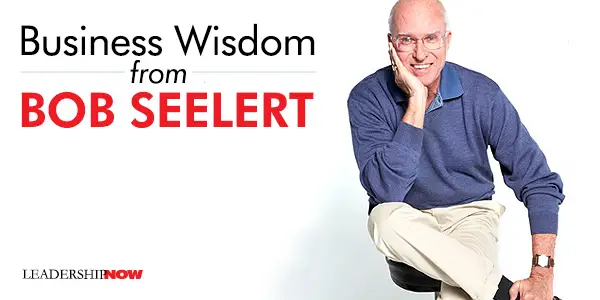
 Seelert says that the most fundamental lesson is that you need to start with the answer in mind and work your way back to the solution. “You have to know where you are going, have the courage to take the first step to get there, and constantly hone the means by which you will reach your destination. Today, too many companies are solution-obsessed and don’t spend enough time up front figuring out the destination, the true answer, and the outcome they are aiming for. You can waste a lot of time and money implementing solutions if you don’t know where you are going.” He has organized his lessons into eight categories representing aspects of personal development in business life: preparation, building and managing a career, business strategy, business operations, finance and economics, leadership, culture and communication, and personal spirit and style. From the very practical advice of “Your Clothes are Talking about You” (when in doubt, dress up) to the more subjective perspective of “Evaluating High Performers,” (consider the size of the footprint) anyone in any context will benefit from the 95 down-to-earth experiences and lessons offered here.Seelert encapsulates each instructive story with a lesson:

Posted by Michael McKinney at 01:15 AM
06.22.09

lead:ology - Leaders vs Managers: A False Dichotomy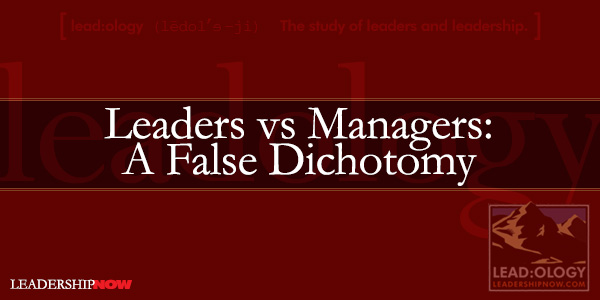
The distinctions made by Bennis are important as they expose two very different and equally valuable mindsets. As each works best in the presence of the other, it is to our advantage that we possess and practice both. As the Teacher so wisely expressed in Ecclesiastes, “There is a time for everything.” It is through a developed sense of awareness and experience that we are able to determine which mindset we need to employ, relative to what and when. We are inclined by our own nature and encouraged by our educational system to favor management. We are content reproducing what we already know—or think we know. We have learned from the neurosciences that the mind is wired for efficiency and is most comfortable reproducing a limited range of responses to help us to better manage and make sense of our world. Management would seem to be our biological default as we tend toward the status quo—to equilibrium—and often for very life-sustaining reasons. But we need leadership to move us out of our comfort zone and grow to new possibilities. It is in the tension between the two—management and leadership—that we can be effective and relevant. Different roles, different results. Thus, both of these roles are needed not only on a personal level but also on a larger organizational level if we are to function efficiently and grow. Management is based on the response to the questions we had yesterday. Today, some of those responses are still valid, many are not. Leadership is needed to address the questions of today and bring us to a different place. This is especially true in times of great change. As noted in Presence: “Our actions are most likely to revert to what is habitual when we are in a state of fear or anxiety…. Even as conditions in the world change dramatically, most businesses, governments, schools, and other large organizations, driven by fear, continue to take the same kinds of institutional actions that they always have…. At best, we get better at what we have always done. We remain secure in the concern of our own worldview, isolated from the larger world.” Debates about which role is better, misses the point. The list isn’t about labels. It’s about different roles that produce different results. By creating a leader-manager distinction, by pulling them apart, we get a better sense of how they fit together. John Kotter makes this clear in What Leaders Really Do: The point here is not that leadership is good and management is bad. They are simply different and serve different purposes. The fundamental purpose of management is to keep the current system functioning. The fundamental purpose of leadership is to produce useful change, especially non-incremental change. It is possible to have too much or too little of either. Strong leadership with no management risks chaos; the organization might walk right off a cliff. Strong management with no leadership tends to entrench an organization in deadly bureaucracy. Management gives leadership a foundation to work from. Leadership keeps us growing and relevant. If a leader can not manage what they have created, then their leadership is not effective and serves no end. I asked Warren Bennis about his thoughts concerning the Leader-Manager distinction twenty years after they were first put into print: Unfortunately and unintentionally, my '89 book, On Becoming a Leader doesn't emphasize the role of and the need for effective managers. I thought then and still think that the distinction is a valid one. At the time I wrote about the differences, I believed that most organizations were under-led and over-managed. I still believe that's true of many of today's organizations. So while I still believe that distinction is still important, what I should have made much, much clearer is that both are important and sometimes those qualities are embodied in many exemplary leaders and, to repeat myself, both are important. If I had made that clearer and added that it's ridiculous to get polarized on the horns of a false dichotomy, I think a lot of folks would have welcomed that distinction. The best leaders I know are both leaders and managers. Warren Bennis’ list of distinctions helps us to understand that as leaders, we can get so busy serving the system that we actually create barriers to leadership. We can easily fall into the trap of leading only to manage what we have created. Leadership is about continually asking the right, challenging questions. It is about renewal. Curiously, we manage better when we chose to lead.
Posted by Michael McKinney at 09:56 AM
06.18.09

What History Can Teach Us About Leadership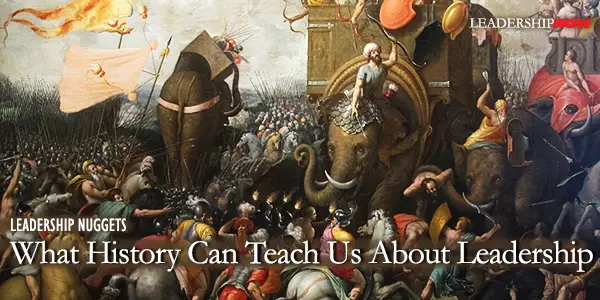
 A couple of years ago while browsing in a local bookstore in Naples, Florida, for something interesting to read, I came across Hannibal Crosses the Alps by John Prevas. It’s the story of the ancient Carthaginian commander who accomplished something that neither his allies nor his enemies thought possible: He led an army, including horses and elephants, over the Alps in winter and then defeated his Roman adversaries in their own backyard. As I reviewed the book in Forbes magazine, two thoughts occurred to me about leadership: (1) Anyone who accomplishes something great, something unique, whether in business or in politics, often does so by defying the conventional thinking of his time. (2) Even though more than two thousand years have passed since Hannibal crossed those Alps, the elements of what it takes to be a successful leader have not changed. They are simple and obvious, or should be: motivating those who follow you to share your vision; inspiring through example; a sense of duty and responsibility to those who trust and depend on you; the capacity to see a problem and the skill to fix it; developing and maintaining a proper perspective on yourself in the face of success or adversity; setting and achieving goals; understanding people’s limits and knowing when to drive hard and when to ease up on both subordinates and competitors. The ancient Greeks tell us that nothing is more important than good leadership for the harmonious functioning of society and nothing hurts more than the lack of it. Our times cry out for leadership— political, financial, and even ethical. Many people are asking today, “Where have the good leaders gone?” In a recent New York Times column about global gridlock entitled “Missing Dean Acheson,” David Brooks posed this question, noting that Americans are about to enter their nineteenth consecutive year of Truman envy. Ever since the Berlin Wall fell in 1989, Brooks observed, people have yearned for a return to a time when leaders such as Harry Truman and George C. Marshall were able to create successful, forward-looking global institutions and policies to confront the challenges that faced America at the end of the Second World War. Brooks asked, “Why can’t we rally that same kind of international cooperation to solve our current economic crisis, confront terrorism, slow down global warming, limit nuclear proliferation, and a host of other pressing problems today?” Ours is a complex and stressful time. We face the most serious financial crisis since the Great Depression of the 1930s and foreign policy issues that if left unsolved could bring us to the brink of nuclear war. Rising new powers in the world today, such as China and India, are changing traditional Western ways of conducting worldwide politics and business. Old powers such as Russia and the members of the relatively new Europe and Union are seeking to advance their influence in the international community. Responses to these developments require effective leadership. The financial crisis and America’s recent foreign policy setbacks can be traced directly to a failure of leadership. But where do we turn for leadership, and what do we want in our leaders? History is one place to look. The past is filled with leaders who possessed extraordinary capabilities, enjoyed tremendous success, and directed societies that experienced problems similar to our own. Their successes and failures as leaders can help us develop a valuable perspective as we grapple with our problems and try to prepare for the future. Similarities between those who ruled the empires of the ancient world and many of today’s corporate and political leaders are remarkable. Times and circumstances may change, but the principles of sound leadership do not. Adapted from Power Ambition Glory: The Stunning Parallels between Great Leaders of the Ancient World and Today . . . and the Lessons You Can Learn by Steve Forbes and John Prevas. Based on an extraordinary collaboration between Steve Forbes, chairman, CEO, and editor in chief of Forbes Media, and classics professor John Prevas, Power Ambition Glory provides intriguing comparisons between six great leaders of the ancient world and contemporary business leaders.
Posted by Michael McKinney at 12:15 AM
06.17.09

Iconoclast: Learning to Think DifferentlyCREATIVITY and imagination is in the space between revolutions and everyday life. They fuel change and, most of the time, progress. Bringing new thinking to old patterns is the job of the leader. In a sense, leaders are to varying degrees, called to be iconoclasts. Neuroscientist Gregory Berns says that not only is an iconoclast a person who does something that others say can’t be done but their mind functions differently than the average mind. Those functions are perception, fear response and social intelligence. Because the mind is designed to function as efficiently as possible, it serves as its own barrier to being an iconoclast. (The brain runs on about 40 watts of power. There is partial truth to the myth that you only use 10-15% of your brain. We use all of our brain, but only a fraction of the brain is active at any given time to conserve energy.) In Iconoclast, Berns explains that “when confronted with information streaming from the eyes, the brain will interpret this information in the quickest and most efficient way possible.” This “efficiency trap” blocks us from seeing alternatives to what we perceive as real; it imposes limitations to what we believe is the only way of seeing something. Iconoclasts don’t allow themselves to fall into the efficiency trap as often as the average person does. “Automatic thinking destroys the creative process.” Berns adds—and the implication is very important—“iconoclasts, either because they were born that way or because they learned how to do it, have found ways to work around the perceptual shortcuts that plague most people.” Thus, we can learn to do this too. Fundamentally, we need to create novel experiences. Iconoclasm begins with perception….Sometimes a simple change of environment is enough to jog the perceptual system out of familiar categories….Unfamiliarity forces the brain to discard its usual categories of perception and create new ones….When confronted with places never seen before, the brain must create new categories. It is in this process that the brain jumbles around old ideas with new images to create new syntheses. The iconoclast’s fear response—specifically the fear of uncertainty and the fear of public ridicule—are different than that of the average person. Fear is damaging to creativity in the workplace. “In many people, the brain would rather avoid activating the fear system and just change perception to conform with the social norm.” You can not eradicate the fear response but you can learn to tame it. “Neuroscience is showing how the rational part of the brain can regain control over such toxic emotions like fear.” The individual who feels overwhelmed by uncertainty or social stresses in the workplace may benefit from taking on projects that have defined endings. Although these may increase in the short term, their completion may actually decrease overall stress. All of this is well and good, but to be a successful iconoclast, you must be able to sell your ideas to other people. That boils down to social intelligence. “As well-respected, upstanding citizens, connectors form the glue of local society. Iconoclasts, by their very nature, upset this delicate web of connectedness. But iconoclasts need connectors. Without them, the iconoclast stands no chance of achieving success. Sometimes iconoclasts have to create the connectors themselves.” Additionally, it is a challenge to leaders to be able to find ways to connect iconoclasts to others so that their talents and insights can be capitalized on organizationally. It is extremely rare for one person to have all three qualities of a successful iconoclast. But you can compensate by building a team around you in areas where you aren’t strong. Iconoclast: A Neuroscientist Reveals How to Think Differently is supported by research and persuasive stories. The immediacy of the topic will be helpful not only to individual development but to organizations seeking to bring new thinking to old patterns of thought. 
Posted by Michael McKinney at 12:42 PM
06.15.09

The Disease of Me"The force of selfishness is as inevitable and as calculable as the force of gravitation"Pat Riley argues that whether we know it or not, all of us are team players and it is through the team that we find significance. Yet the team can be undermined by the Disease of Me. In The Winner Within, he describes it as the overpowering belief in the importance of oneself. “The most difficult thing for individuals to do when they’re part of the team is to sacrifice. It is so easy to become selfish in a team environment.” The Disease of Me is ever present, but it can be anticipated and overcome. Riley lists the following symptoms of the disease:
What about the teams in your life? Are they due for a checkup?
Posted by Michael McKinney at 12:11 AM
06.12.09

Think Again: Why Good Leaders Make Bad Decisions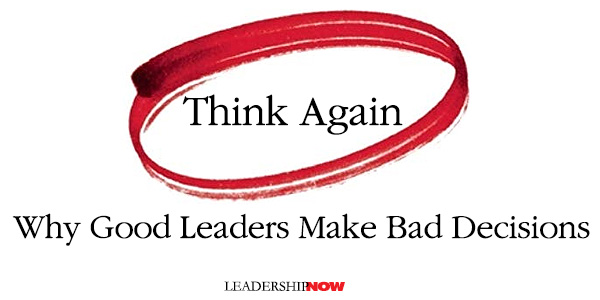
WHY DO GOOD LEADERS make bad decisions? This question is at the heart of Sydney Finkelstein, Jo Whitehead and Andrew Campbell’s book, Think Again. The authors begin their analysis with the notorious 2005 hurricane Katrina disaster. As the retelling of the events are explained, you might even find yourself compelled to stop waving your placard, change your t-shirt, pull up a chair and listen for understanding. A series of understandable mistakes—errors of judgment—were made by very competent people. The same kinds of errors of judgment that we all make. A bad decision starts with at least one influential person making an error of judgment. But normally, the decision process will save the day: facts will be brought to the table that challenge the flawed thinking, or other people with different views will influence the outcome. So the second factor that contributes to a bad decision is the way the decision is managed: for whatever reason, as the decision is being discussed, the erroneous views are not exposed and corrected.Drawing on the findings of brain research, they conclude that “our brains use two processes that enable us to cope with the complexities we face: pattern recognition and emotional tagging.” Neither of these is inherently bad, in fact, they are quite helpful and necessary much of the time. The problem is when we are faced with new types of input that do not match up with our previous experiences. This most often leads to flawed thinking. They describe four conditions under which flawed thinking is most likely to happen. The first two are pattern recognition problems and the latter are emotional tagging issues.
  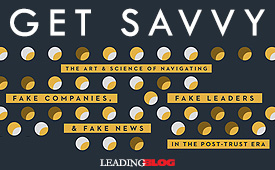
Posted by Michael McKinney at 09:34 AM
06.11.09

Books To Read Before You Lead - Paradigms While the word paradigm has been worked to death, understanding the rules that govern the behavior and thinking of individuals and groups is no less important. Paradigms reflect our view of the world and to a large extent predict our behavior. Adam Smith wrote in Powers of the Mind, “When we are in the middle of the paradigm, it is hard to imagine any other paradigm.” The point is, if you can change the rules, you can change the future. Barker argues that paradigm pliancy is the best strategy in turbulent times. Paradigm pliancy “is the purposeful seeking out of new ways of doing things. It is an active behavior in which you challenge your paradigms on a regular basis by asking the Paradigm Shift Question:” What do I believe is impossible to do in my field, but, if it could be done, would fundamentally change my business?And then asking the question: Who outside my field, might be interested in my unsolved problems?For leaders he offers the following thoughts. Keep in mind that managing and leadership are not mutually exclusive functions, but are best served in the presence of the other. You manage within a paradigm.
Posted by Michael McKinney at 10:44 AM
06.08.09

Lead, Sell, or Get Out of the Way Lead, Sell, or Get Out of the Way by Ron Karr provides more evidence that leadership isn’t just about a few titled people at the top. It is a choice to think differently. Leadership is a choice to think differently about anything you do. Selling is no exception and is closely linked to the functions of a leader. Leadership is not always about people we “lead” in the conventional sense, but is frequently about people we must influence. Karr writes, “Whether you sell a product, a service, or an idea, you must be able to influence other people as leaders do.”
Lead, Sell, or Get Out of the Way by Ron Karr provides more evidence that leadership isn’t just about a few titled people at the top. It is a choice to think differently. Leadership is a choice to think differently about anything you do. Selling is no exception and is closely linked to the functions of a leader. Leadership is not always about people we “lead” in the conventional sense, but is frequently about people we must influence. Karr writes, “Whether you sell a product, a service, or an idea, you must be able to influence other people as leaders do.”
It begins with being able to and understanding the need to engage others in continuous strategic conversations as part of the normal way of doing things—a process Karr has termed Integrated Dialogue. Integrated dialogue is a conversation of shared purpose that draws people out “to create a powerful relationship, one that identifies whole new zones of mutual opportunity, addresses far-ranging issues, and positions you as an invaluable resource: a leader.” As with all leaders, salespeople too will succeed when they fully appreciate the many relationships inherent in their success. Sales leaders lead a whole cast of people in their own organizations from the customer service, tech people to accounting and senior management. In addition, they lead not only their customer or end-user but also many points of contact in their customer’s organization that are likely to have some input on the buying decision like operations, accounting, purchasing, and senior management. Gone are the days where everything filters through the salesperson. “Your success as a salesperson depends on your ability to build and sustain coalitions both inside and outside your organization. You must create and lead the coalition, no matter what you are selling.” This will resonate with any leader: Your job is to manage multiple constituencies and alliances and to use those alliances to identify new and better ways of generating the desired results. Your job is to do what most salespeople don’t do: lead the conversation with your prospects and customers about the results they need, the problems they have, and the obstacles they face. To make this happen you must possess and develop the belief that you have everything you need and can build on that, the belief that you can improve any area of your life, everything is possible, preparation maximizes your potential, and your customers—the people you need to influence—come first. After laying the groundwork, Karr defines and explains the seven traits that great sales leaders share:
Karr demonstrates how to move from task-oriented selling (which is what most salespeople do) to purpose-oriented selling. These principles are worth bearing in mind on a personal development level as well. Karr encourages, “The bottom line is that you have the ability to increase your sphere of influence and sales just by the way you act toward those you are trying to influence.” Change your conversations, change your outcomes. Leaders in any field will find much here to assimilate into their daily activities. Read it and grow. 
Posted by Michael McKinney at 11:15 AM
06.05.09

Newswire: Herbert Hoover and His Times
Posted by Michael McKinney at 07:22 AM
06.04.09

Are You Dealing With Insecurity?We all harbor some insecurity; even if it’s just trying to hide the fact that we do. But it is not something we can ignore. Too much insecurity can cripple our leadership and anyone we lead.In Building Your Leadership Resume, president of the Southern Baptist Convention and pastor Johnny Hunt outlines nine characteristics of an insecure leader: • An insecure leader has a hard time giving credit to others. “Why should praise seem like an unrecoverable cost? It is a gift that gives back to everyone.” • An insecure leader keeps information from his staff. “When you release information, you convey trust and confidence to others. When you conceal it, you convey just the opposite: no trust, no confidence.” • An insecure leader doesn’t want his staff exposed to other leaders—people who may possess qualities you don’t, people who may have skills your staff wishes you had. “When one person grows the whole team grows….Give your people the best—even better than you are.” • An insecure leader is often a micromanager. “He’s a control freak.” Nothing can happen that they are not fully aware of. They fear things will fall apart without them. This kind of oppressive control can wring the life out of your team. • Insecure leaders are too needy of praise. “For this reason, more than perhaps any other, they can’t really be leaders. When someone needs his followers to always be telling him how wonderful he is, he works in direct opposition to the heartbeat of leadership, which is: building into other’s lives.” • Insecure leaders don’t provide security for those they lead. “If the mood and environment in the office is one of fear, second-guessing, and self-doubt, you can be sure an insecure leader is in charge.” • Insecure leaders take more than they give. Instead of validating and encouraging others, they are focused on receiving it. • Insecure leaders limit their best leaders. “Insecure leaders cannot genuinely celebrate the victories won by others.” • Insecure leaders limit their organization. “Not only does insecurity throttle down the horsepower of individual team members; it results in putting restraints on the whole church or organization.”
Posted by Michael McKinney at 09:37 AM
06.03.09

Whatever Happened to the Rugged Individualist?“Corporate America is in the midst of a crisis” write Jonathan Littman and Marc Hershon in I Hate People! “The spirit of the individual has played a huge part in forging our nation’s history. Yet the scourge of teamwork pap has made solo efforts in companies seem unwanted, crazy, even dangerous.“Instead of thinking of yourself as a staffer in a big company, the manager of a division, or a top executive, you begin to define yourself in concrete individualistic terms. You are a brand unto yourself. Brainstormer extraordinaire. Marketing whiz. Charismatic project leader.” At the same time the soloist is not a loner, a recluse or a maverick. They fit smoothly within a group, playing with it expertly while often leading or accompanying fellow members. I Hate People! Kick Loose from the Overbearing and Underhanded Jerks at Work and Get What You Want Out of Your Job is a guide for navigating through the kinds of people in the workplace that make us all miserable and undermine rugged individualists. How do you know if you're a Soloist, or at least destined to become one? The easiest sniff test is how many times a day you mutter, shout, or even think to yourself, "I hate people!" But not all People Haters are necessarily Soloists. Littman and Hershon have created the Am I a Soloist Quiz to help you determine the depth of your Soloist leanings. The higher your score, the more Soloist blood in your veins. A. The portion of the day I prefer working by myself is . . .
Posted by Michael McKinney at 04:55 PM
06.01.09

First Look: Leadership Books for June 2009Here's a look at some of the best leadership books to be released in June.




For bulk orders call 1-800-423-8273
Posted by Michael McKinney at 12:36 AM
|
BUILD YOUR KNOWLEDGE


How to Do Your Start-Up Right STRAIGHT TALK FOR START-UPS 
Grow Your Leadership Skills NEW AND UPCOMING LEADERSHIP BOOKS 
Leadership Minute BITE-SIZE CONCEPTS YOU CAN CHEW ON 
Classic Leadership Books BOOKS TO READ BEFORE YOU LEAD |
|